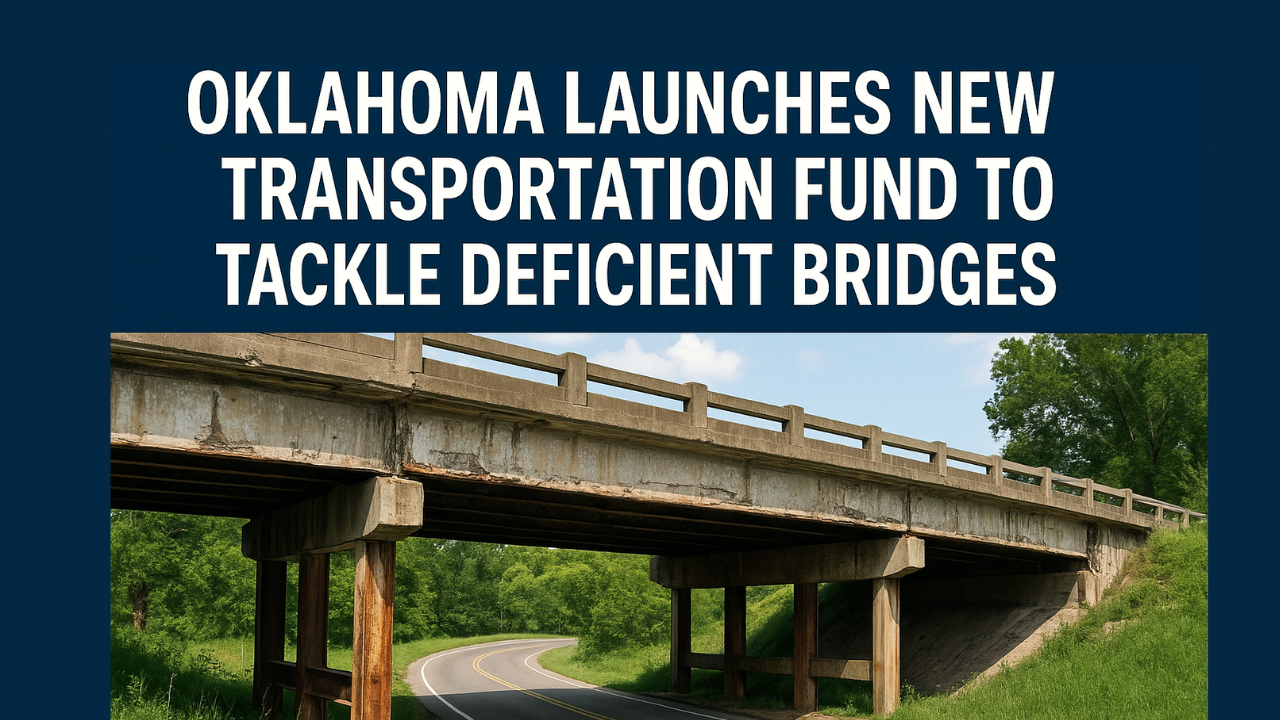Oklahoma has unveiled a new transportation funding initiative designed to address the growing number of deficient bridges across the state.
With the passage of House Bill 2758, signed into law on May 30, the state embarks on one of its largest single-year investments in county-level transportation infrastructure.
Introduction of the PACT Fund
The newly formed Preserving and Advancing County Transportation (PACT) Fund will be housed within the Oklahoma State Treasury.
Beginning July 1, the fund will be supported by allocations from the gross production tax on natural gas, which previously funneled into the General Revenue Fund.
According to Rep. Trey Caldwell (R-Lawton), the fund will generate an annual financial impact of $71 million.
How the Revenue Is Distributed
The revenue from the gross production tax will now be distributed across four categories:
- 40% to the PACT Fund, capped at $75 million annually
- 10% to school districts and counties
- 40% to the General Revenue Fund, up to the five-year moving average
- Any excess beyond that average will be sent to the Revenue Stabilization Fund
Ensuring Equitable Transportation Improvements
Sen. John Haste (R-Broken Arrow) emphasized that this funding will help equalize road quality statewide, particularly aiding areas where access for school buses and emergency vehicles is inadequate.
“Counties can now undertake major roadwork and bridge projects that have long been postponed due to insufficient funds,” Haste stated.
Detailed Allocation Criteria for Counties
The PACT Fund will be divided as follows:
- Two-thirds of the fund will be distributed based on each county’s highway construction and maintenance ratio, aiming for a target balance of $4,000 per county road mile.
- One-third of the funding is earmarked for county bridge reconstruction on roads classified as major collector routes.
To access this funding, counties must submit project proposals to the Oklahoma Department of Transportation (ODOT) for review against specific evaluation criteria detailed in the bill.
Broad-Based Support and County Responsibilities
This legislative effort was spearheaded through a partnership between the Oklahoma Legislature, Governor Kevin Stitt, and the Association of County Commissioners of Oklahoma (ACCO).
It aims to benefit all 77 Oklahoma counties, which are tasked with maintaining approximately 75% of the state’s roads and over 60% of the bridges, as per the Oklahoma County Commissioners’ website.
Rep. Caldwell emphasized the urgency of the issue, stating, “Counties maintain the majority of Oklahoma’s roadways and bridges, so it’s vital we give them the financial tools necessary to ensure public safety and support commerce.”
Rising Costs and Infrastructure Challenges
COVID-19’s Impact on Construction Expenses
Chris Schroder, Executive Director of ACCO, highlighted that infrastructure costs have surged since the COVID-19 pandemic began in 2020.
The rise in prices for equipment, asphalt, and other road-building materials has made it increasingly difficult for rural counties to fund critical projects.
Schroder believes the PACT Fund will be especially impactful in these underserved areas, although all Oklahoma counties stand to gain from the law.
“A large portion of this funding is geared toward rural counties that typically receive less for road projects. Around one-third is dedicated to bridge repairs, which are needed across both urban and rural regions,” Schroder explained.
A Moving Target: The Fight Against Deficient Bridges
Nearly two decades ago, Oklahoma had over 6,800 structurally deficient bridges. Legislative funding in the mid-2000s brought that number down to approximately 1,500, but further progress has stalled due to inflation in construction costs.
“A bridge that cost $5 million five years ago might now run up to $8 million,” said Schroder, noting that new deficient bridges are added each year as older ones deteriorate.
The goal, according to Schroder, is to replace aging bridges faster than new ones appear on the list, which makes it a constantly shifting challenge. He added, “This investment should help us make headway in reducing the number of unsafe bridges across the state.”
The establishment of the PACT Fund marks a significant step forward in modernizing Oklahoma’s county infrastructure.
By leveraging revenue from natural gas production, the state aims to address critical transportation issues, reduce the backlog of deficient bridges, and provide counties—especially rural ones—with the resources to maintain vital public roadways. The long-term objective is clear: improve safety, access, and connectivity across all 77 counties.




